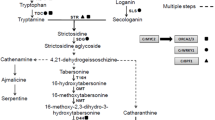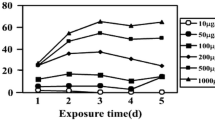Abstract
It was found previously that in the mustard (Sinapis alba L.) seedling (Schuster et al. 1989, Planta 177, 74–83) the action of nitrate and phytochrome on the appearance of cytosolic nitrate reductase (NR) is abolished if the plastids are damaged by photooxidation. In the present study this finding has been corroborated by the following results: (i) the appearance and disappearance of NR activity are strictly correlated with the appearance and disappearance of immunoresponsive NR protein; (ii) the appearance of NR correlates with the appearance of translatable NR mRNA; (iii) photodestruction of the plastids strongly reduces the level of NR mRNA. It is concluded that the dependence of the NR level on the state of the plastids can be detected at the level of its mRNA and is not attributable to an inactivation of the enzyme.
Similar content being viewed by others
Abbreviations
- NR:
-
nitrate reductase (EC 1.6.6.1)
References
Bonner, W.M., Laskey, R.A. (1974) A film detection method for tritium labelled proteins and nucleic acids in polyacrylamide gels. Eur. J. Biochem. 46, 83–88
Brödenfeldt, R., Mohr, H. (1986) Use of immunotitration to demonstrate phytochrome-mediated synthesis de novo of chalcone synthase and phenylalanine ammonia lyase in mustard seedling cotyledons. Z. Naturforsch. 41c, 61–68
Commère, B., Chérel, I., Kronenberger, J., Galangau, F., Caboche, M. (1986) In vitro translation of nitrate reductase messenger RNA from maize and tobacco and detection with an antibody directed against the enzyme of maize. Plant Sci. 44, 191–203
Frosch, S., Jabben, M., Bergfeld, R., Kleinig, H., Mohr, H. (1979) Inhibition of carotenoid biogenesis by the herbicide SAN 9789 and its consequences for the action of phytochrome on plastogenesis. Planta 145, 497–505
Jakobs, M., Mohr, H. (1966) Kinetische Studien zur phytochrominduzierten Proteinsynthese. Planta 69, 187–197
Link, G. (1982) Phytochrome control of plastid mRNA in mustard (Sinapis alba L.). Planta 154, 81–86
Melzer, J.M., Kleinhofs, A., Warner, R.L. (1989) Nitrate reductase regulation: Effects of nitrate and light on nitrate reductase mRNA accumulation. Mol. Gen. Genet. 217, 341–346
Mohr, H. (1957) Der Einfluß monochromatischer Strahlung auf das Längenwachstum des Hypokotyls und auf die Anthocyan-bildung bei Keimlingen von Sinapis alba L. Planta 49, 389–405
Mohr, H. (1966) Untersuchungen zur phytochrominduzierten Photomorphogenese des Senfkeimlings (Sinapis alba L.). Z. Pflanzenphysiol. 54, 63–83
Mohr, H., Drumm-Herrel, H. (1981) Interaction between blue/UV-light and light operating through phytochrome in higher plants. In: Plants and the daylight spectrum, pp. 423–441, Smith, H., ed. Academic Press, New York
Oaks, A., Poulie, M., Goodfellow, V.J., Cass, L.A., Deising, H. (1988) The role of nitrate and ammonium ions and light on the induction of nitrate reductase in maize leaves. Plant Physiol. 88, 1067–1072
Oelmüller, R. (1989) Photooxidative destruction of chloroplasts and its effect on nuclear gene expression and extraplastidic enzyme levels. Photochem. Photobiol. 49, 229–239
Oelmüller, R., Briggs, W.R. (1990) Intact plastids are required for nitrate- and light-induced accumulation of nitrate reductase activity and mRNA in squash cotyledons. Plant Physiol. (in press)
Oelmüller, R., Mohr, H. (1986) Photooxidative destruction of chloroplasts and its consequences for expression of nuclear genes. Planta 167, 106–113
Rajasekhar, V.K., Gowri, G., Campbell, W.H. (1988) Communication: Phytochrome-mediated light regulation of nitrate reductase expression in squash cotyledons. Plant Physiol. 88, 242–244
Reiß, T., Bergfeld, R., Link, G., Thien, W., Mohr, H. (1983) Photooxidative destruction of chloroplasts and its consequences for cytosolic enzyme levels and plant development. Planta 159, 518–528
Redinbaugh, M.G., Campbell, W.H. (1985) Quaternary structure and composition of Squash NADH: nitrate reductase. J. Biol. Chem. 260, 3380–3385
Schuster, C., Oelmüller, R., Mohr, H. (1987) Signal storage in phytochrome action on nitrate-mediated induction of nitrate and nitrite reductases in mustard cotyledons. Planta 171, 136–143
Schuster, C., Oelmüller, R., Mohr, H. (1988) Control by phytochrome of the appearance of ribulose-1,5-bisphosphate carboxylase and the mRNA for its small subunit. Planta 174, 426–432
Schuster, C., Schmidt, S., Mohr, H. (1989) Effect of nitrate, ammonium, light and a plastidic factor on the appearance of multiple forms of nitrate reductase in mustard (Sinapis alba L.) cotyledons. Planta 177, 74–83
Author information
Authors and Affiliations
Additional information
This research was supported by a grant from the Deutsche Forschungsgemeinschaft. We are greatly indebted to Dr. Ann Oaks (University of Guelph, Ontario, Canada) for the gift of antiserum.
Rights and permissions
About this article
Cite this article
Schuster, C., Mohr, H. Photooxidative damage to plastids affects the abundance of nitrate-reductase mRNA in mustard cotyledons. Planta 181, 125–128 (1990). https://doi.org/10.1007/BF00202334
Received:
Accepted:
Issue Date:
DOI: https://doi.org/10.1007/BF00202334




